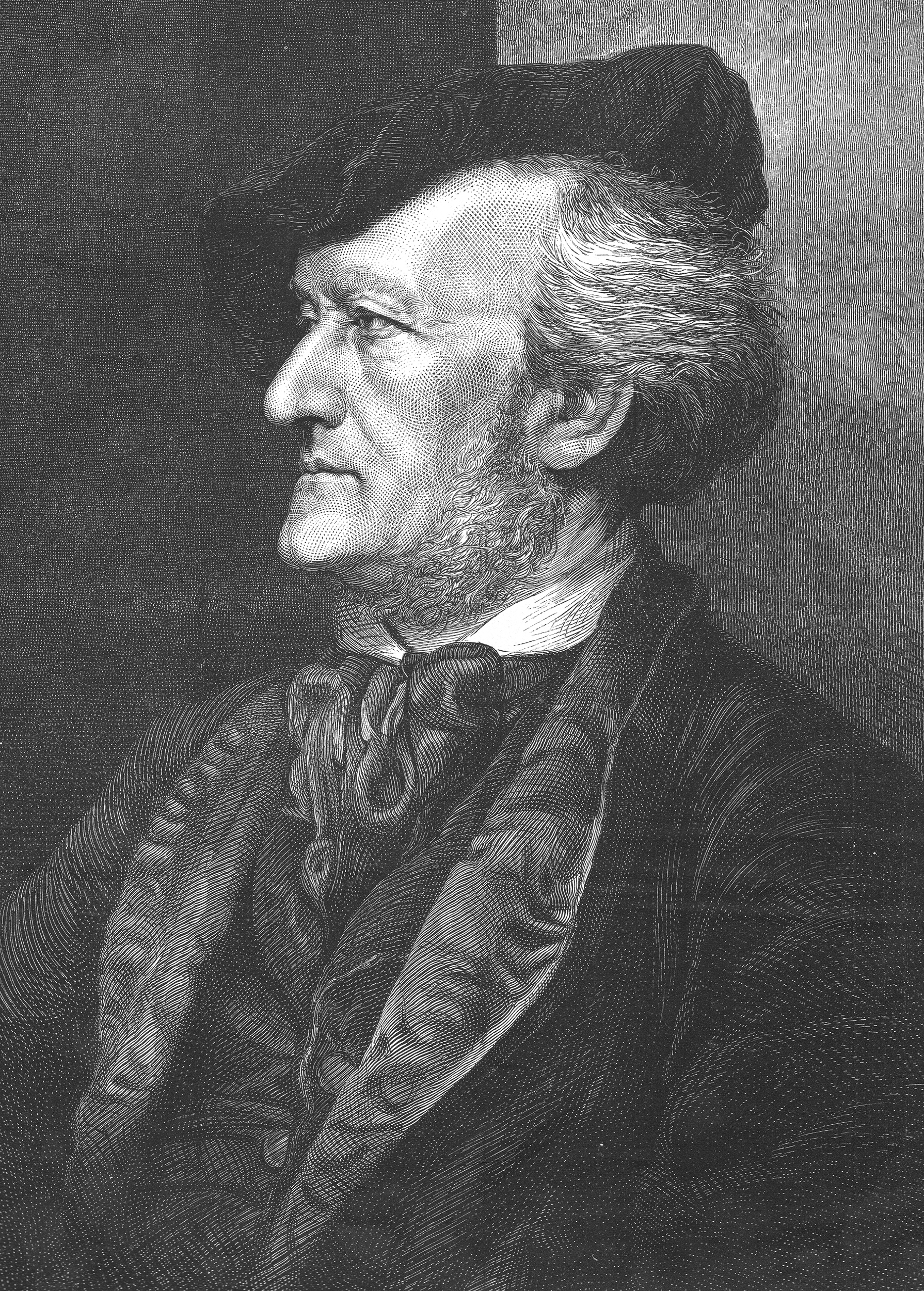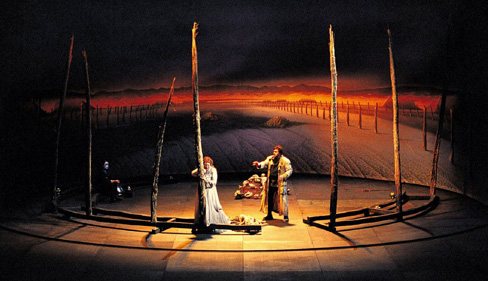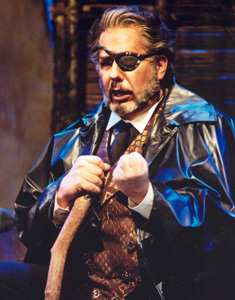Ring of the Nibelung, The, is a cycle of four operas by the German composer Richard Wagner. Its title in German is Der Ring des Nibelungen. The Ring cycle is one of the greatest stage spectacles in opera, with a musical score that requires a large orchestra containing instruments that were Wagner’s own inventions, notably the Wagner tuba and the stierhorn, an instrument modeled on the ancient cow horn. Recurring themes in the music, called leitmotifs, depict certain characters and concepts. Wagner wrote the libretto (text) himself, in German, basing the story on the ancient German poem Das Nibelungenlied and on Teutonic mythology.

The Ring cycle consists of three operas, each of three acts, with a shorter, one-act opera, Das Rheingold (The Rhine Gold, 1869), serving as a prologue. The three main operas are Die Walkure (The Valkyrie, 1870); Siegfried (1876); and Gotterdammerung (The Twilight of the Gods, 1876). The four works were first performed as a cycle at the opening of the Festival Opera House in Bayreuth, Germany, in August 1876. The operas have a continuous plot, depicting the decline and downfall of the gods, brought about by their greed and lust for power.
The Rhine Gold.
The Rhinemaidens guard a treasure of gold on the bottom of the Rhine River. Alberich, one of a race of dwarfs called Nibelungs, when unsuccessful in wooing the Rhinemaidens, steals the gold. He uses some of it to make a ring that gives superhuman powers to whoever possesses it. Wotan, the chief of the gods, captures Alberich and releases him only after he yields both the ring and the gold. Alberich then puts a curse on the ring. Wotan is forced to use the gold as well as the ring to pay two giants, Fafner and Fasolt, for building Valhalla, a fortress home for the gods. The first victim of the curse is Fasolt, who is killed by Fafner, but Wotan’s brief possession of the ring means that the gods are also cursed.
The Valkyrie.
Wotan has descended to earth in an attempt to restore the ring to the Rhinemaidens and remove the curse. He has two children, Siegmund and Sieglinde, by a mortal woman. The pair have long been separated, and Sieglinde has married a woodsman, Hunding. When Siegmund seeks shelter from a storm in Hunding’s hut, the brother and sister fail to recognize each other, but they feel a strange mutual attraction. Hunding, recognizing Siegmund as the man who has killed a member of his family, challenges him to single combat the following day. Siegmund manages to retrieve the sword Nothung, which Wotan has driven into a tree. He and Sieglinde then run away together.

In Valhalla, Fricka, goddess of marriage, compels her husband, Wotan, to support Hunding in the coming fight. But Brunnhilde, one of the Valkyries—the nine warrior-daughters of Wotan and the earth goddess Erda—disobeys him and helps Siegmund. In the fight, Wotan shatters Nothung, leaving Siegmund to be slain by Hunding. Wotan then kills Hunding himself. Brunnhilde gives the fragments of the sword to Sieglinde for safekeeping, and Sieglinde is able to escape to the forest.
Loading the player...The Ring of the Nibelung: The Valkyrie
Siegfried.
Sieglinde has died giving birth to Siegfried, her son by Siegmund, and the boy has been brought up by Mime, Alberich’s brother. Siegfried, now a young man, lives with Mime in the forest. Nearby is the cave where Fafner, now transformed into a dragon, guards the Rhine gold. Mime has long been trying to weld together the fragments of Nothung so that Siegfried can kill Fafner and get the treasure for him. He plans to kill Siegfried as soon as Fafner is dead. Wotan, disguised as a wanderer, appears and predicts that only a hero can reforge Nothung.

Siegfried successfully reforges Nothung and slays Fafner. When Siegfried sucks his hand where some of Fafner’s blood has fallen, he is suddenly able to understand the language of the birds. One of them reveals Mime’s treachery and also tells him of Brunnhilde, the sleeping Valkyrie. Siegfried kills Mime and, taking the ring and the Tarnhelm, a helmet that allows the wearer to assume any shape or disguise, follows the bird to Brunnhilde’s mountain. The wanderer bars his way, but Siegfried shatters his spear with Nothung, strides into the fire, and claims Brunnhilde as his bride.
The Twilight of the Gods.
Siegfried entrusts the ring to Brunnhilde and departs in search of adventure. He arrives at the hall of the Gibichungs, presided over by Gunther, his sister Gutrune, and their half-brother Hagen, the son of Alberich. Hagen hatches a plan to take possession of the ring. He gives Siegfried a drug that makes him forget Brunnhilde, then arranges for him to marry Gutrune and to capture Brunnhilde as a bride for Gunther. Using the Tarnhelm to disguise himself as Gunther, Siegfried captures Brunnhilde (whom he does not recognize), tears the ring from her finger, and brings her to the Gibichungs’ hall. Hagen summons the Gibichungs for the double wedding. Seeing the ring on Siegfried’s finger, Brunnhilde accuses him of treachery and conspires with Hagen and Gunther to murder him.
Loading the player...The Ring of the Nibelung: The Twilight of the Gods
Hagen kills Siegfried and, in a quarrel over the ring, later kills Gunther. He tries to remove the ring from Siegfried’s finger but fails. Brunnhilde has learned how Siegfried has been manipulated and resolves to die, too. Siegfried’s body is laid on a funeral pyre. As it is set alight, Brunnhilde mounts her horse and rides into the flames. With her sacrificial death, Brunnhilde lifts the curse of the ring and redeems humankind. But the gods are already doomed. As the flames of the pyre die away, the waters of the Rhine rise up to cover the ashes and the Rhinemaidens recover the ring. Hagen, making a desperate attempt to seize it, is dragged down to a watery death. Valhalla appears in flames, and the kingdom of the gods is destroyed.
See also Valkyrie.
